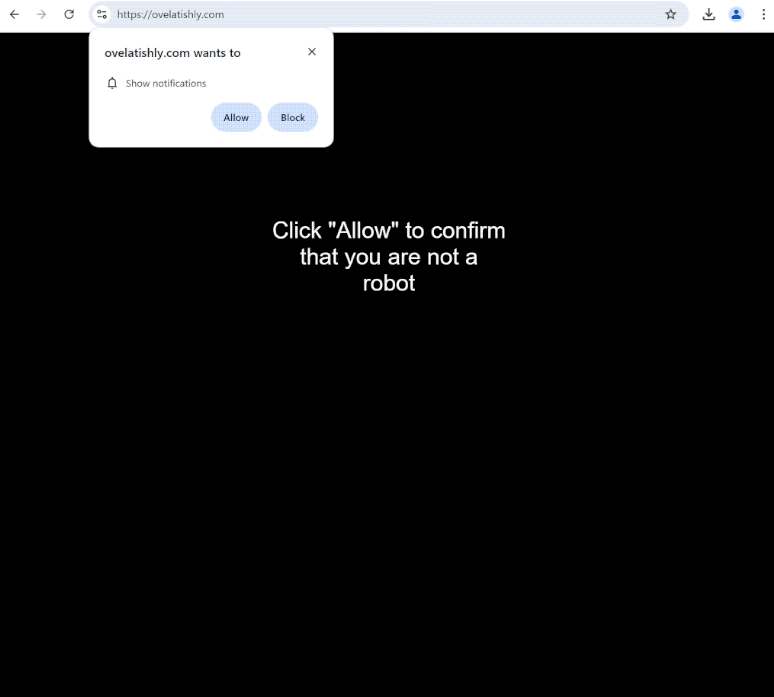How to stop ovelatishly.com notifications
ovelatishly.com is a generic scam website that tries to trick users into allowing ads on their desktops. To spam users with ads, the site misuses a legitimate browser feature, which is why you will get a browser alert saying “ovelatishly.com wants to show notifications” as soon as you enter the site. Clicking “Allow” would authorize the site to show ads directly on your desktop.
ovelatishly.com does not have any content on it, only a message saying you need to click “Allow” to confirm you are not a robot. Immediately upon entering the site, a browser alert will appear saying “ovelatishly.com wants to show notifications”. If you click “Allow”, the site will be authorized to spam ads. These ads can be disguised as system notifications to trick users into interacting with them. These notifications appear similarly to where legitimate system notifications appear. Interacting with those notifications is not recommended because you could be redirected to websites that promote scams or conceal malware. If you have given the site permission, you can easily revoke it.
This “show notifications” feature is legitimate, and even if it’s often misused by sites like ovelatishly.com, it can be useful. Provided a site is safe, you can authorize it to show you notifications if they’re something you want to see. If, for example, you frequent a specific website and want to see its contents more conveniently, you can allow it to show notifications. You can easily revoke the site’s permission in your browser’s settings.
We strongly recommend scanning your computer with the anti-virus program WiperSoft because redirects could be a symptom of an adware infection. You should also have an adblocker program.
What triggers redirects to sites like ovelatishly.com
Most likely, you are redirected to sites like ovelatishly.com because you do not have an adblocker program enabled when browsing high-risk and ad-heavy sites. Clicking on anything on those websites (e.g. sites that have pirated or pornographic content) will likely trigger a redirect. Fortunately, both ads and redirects are easily blockable with an adblocker program. In rare cases, adware can also be the trigger.
If adware is what triggers the redirects, you should also notice other symptoms, such as an increase in regular ads. Adware, browser hijackers, and similar infections usually get installed via the software bundling method. The way it works is infections are added to popular free programs as extra offers, which are authorized to be installed alongside automatically. The offers are optional but they need to be manually deselected to prevent their installation. However, this is made difficult by the fact that these offers are hidden in settings users don’t normally use. This is why software bundling is a rather controversial installation method. Anti-virus programs typically detect programs that use software bundling as potential threats.
If you pay attention when installing programs, there should be no issue with preventing unwanted installations. When installing a program, you will be given the option to pick the settings you want to use. The installation window recommends using Default settings but if you use Default, all added offers will be permitted to install. What you should choose is Advanced settings. These settings will clearly display all offers, and you will be able to deselect the ones you do not want. Simply uncheck the boxes. We always recommend deselecting all offers, even if they appear useful at first. If you allow these installations, you will quickly fill your computer with junk programs. These junk programs can be difficult to get rid of once installed.
How to stop ovelatishly.com redirects
To check for an adware infection, scan your computer with the anti-virus program WiperSoft. Redirects could be a sign of an infection. Furthermore, install a good adblocker program to block both redirects and ads while browsing.
It’s not difficult to revoke the site’s permission to show you notifications in your browser’s settings. If you need assistance, use the instructions below. In addition to ovelatishly.com, you should also remove all other unknown websites. And if you no longer want to get the notification requests, you can stop them altogether.
- For Mozilla Firefox: Open Menu (the three bars top-right corner) -> Options -> Privacy & Security. Scroll down to Permissions, press Settings next to Notifications, and remove ovelatishly.com and any other questionable websites. You can permanently turn off these notification requests by checking the “Block new requests asking to allow notifications” box in the same Notifications settings.
- For Google Chrome: Open Menu (the three dots top-right corner) -> Settings -> Privacy and security -> Site Settings. Click on Notifications under Permissions, and remove ovelatishly.com and any other questionable websites. You can stop these notification requests permanently by toggling off “Sites can ask to send notifications”.
- For Microsoft Edge: Open Menu (the three dots top-right corner) -> Settings -> Cookies and site permissions -> Notifications. Review which sites have permission and remove ovelatishly.com and any other questionable websites. You can permanently turn off these notification requests by toggling off “Ask before sending”.
Site Disclaimer
WiperSoft.com is not sponsored, affiliated, linked to or owned by malware developers or distributors that are referred to in this article. The article does NOT endorse or promote malicious programs. The intention behind it is to present useful information that will help users to detect and eliminate malware from their computer by using WiperSoft and/or the manual removal guide.
The article should only be used for educational purposes. If you follow the instructions provided in the article, you agree to be bound by this disclaimer. We do not guarantee that the article will aid you in completely removing the malware from your PC. Malicious programs are constantly developing, which is why it is not always easy or possible to clean the computer by using only the manual removal guide.

